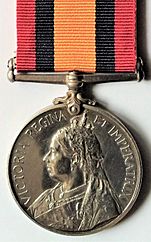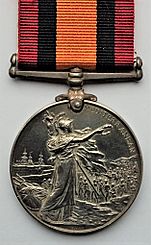Queen's Mediterranean Medal facts for kids
The Queen's Mediterranean Medal was a special award created by King Edward VII in 1902. It was given to certain soldiers who helped during the Second Boer War (1899-1902). These soldiers were part of the British Militia, which was a group of part-time soldiers.
Their job was to take over duties from regular Army troops. This happened in important military bases around the Mediterranean, like Gibraltar, Malta, and Egypt. By doing this, the regular army soldiers were free to go and fight in the Boer War in South Africa.
What is the Queen's Mediterranean Medal?
This medal looks very much like another medal called the Queen's South Africa Medal (1899-1902). They have the same design and ribbon. However, there is one key difference. On the back of the Queen's Mediterranean Medal, the word 'SOUTH AFRICA' is replaced with 'MEDITERRANEAN'.
The medal is a silver disk, about 36 millimeters wide. It was given without any extra bars or "clasps" attached to the ribbon. Each medal also had the recipient's name and other details carved into its edge.
Who Received the Medal?
Around 5,000 Queen's Mediterranean Medals were given out. They were awarded to officers and soldiers from specific Militia battalions. These battalions were:
- The Third (Militia) Battalions of the Royal Northumberland Fusiliers
- The Royal Fusiliers
- The West Yorkshire Regiment
- The Royal North Lancashire Regiment
- The Royal West Kent Regiment
- The King's Own Yorkshire Light Infantry
- The Seaforth Highlanders
- The Royal Munster Fusiliers
Images for kids





